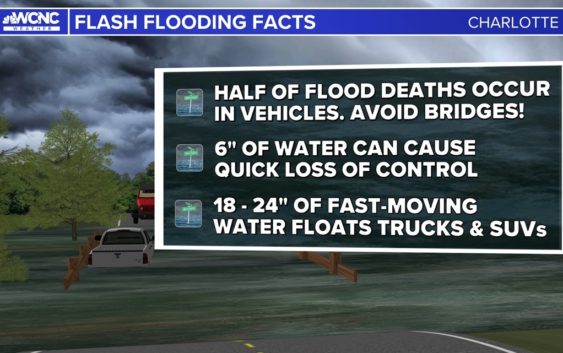- Severe weather threat dwindles Sunday night
- Tornado Watch for Coastal Plains Sunday evening
- Four people, including an infant, dead after Oklahoma tornadoes; governor declares state of emergency
- Two people, including a child, dead after Oklahoma tornadoes; governor declares state of emergency
- Build your hurricane season preparedness kits this tax-free weekend
Weather IQ: Understanding the local risk from flash flooding

Severe Weather Preparedness Week continues with our biggest local threat: flash flooding.
CHARLOTTE, N.C. — Flash flooding is the most common and most expensive natural disaster in the Carolinas. In fact, there have been over 1,000 floods over the past decade. Hurricanes, tropical storms, thunderstorms, and training events can all produce flash flooding.
Flooding is the second-highest cause of weather-related deaths across the United States. It’s why you’ll hear “turn around, don’t drown” repeated many times during severe weather coverage.
Most deaths from flooding happen in cars. It takes just 6 inches of fast-moving water to sweep a person off their feet. 12 to 24 inches can sweep away a vehicle – including trucks and SUVs. Most flooding deaths are preventable with the right knowledge.
A common mistake humans make is driving through a flooded roadway. Barrier or no barrier – it’s not safe if you see water. You don’t know the depth of the water, what lurks beneath, or even the condition of the road. This is even more dangerous at night.
You may trust yourself to swim or wade through, but most people underestimate the force and power of water. Critters under the black water are also a risk – reports of alligators, rodents, snakes, spiders, and even fire ants have occurred across the country.
Flash flooding happens after heavy rain over a short period of time. Think of the ground like a sponge: a sponge can only soak up so much water. And all sponges, like different locations, can hold more or less runoff. Once rain rates exceed what the ground can handle, and runoff areas like streams and creeks hit their maximum, water will begin to overflow leading to flash flooding.
Most flash floods occur in low-lying areas where water can collect easily, or in urban areas with lots of concrete where storm drains fill quickly. The amount of concrete lessens the amount of runoff the natural ground can soak in.
You should also be aware of the flooding threat to your home or even your business. This data is available through FEMA. They can tell you your risk by assessing whether your home is in or near a flood plain and assist with other common questions.
If you ever get caught in a flash flood, residents are advised to move to higher ground immediately. If flooding water engulfs your vehicle, things get a little more complicated. It’s recommended to abandon your car if rising floodwaters surround you – but the water must be still or only a few inches deep. However, if the water is moving quickly or rising rapidly, stay put and call for help. You can climb to the roof if water enters your vehicle while waiting for rescue.
When and where flash flooding occurs can be unpredictable, especially during what the public perceives as a “regular” thunderstorm. Having a reliable way to get weather alerts is crucial and understanding those alerts is even more important.
According to the National Weather Service, a Flood Advisory means be aware. This is typically for a nuisance event that won’t be bad enough to issue a warning. A Flood Watch means be prepared as conditions are more favorable for flooding. This can be the amount of rain, an already saturated ground, or even the risk for quick runoff, like in a mountainous region.
If at any point a warning is issued, this means take action. A Flood Warning will be issued when a hazardous weather event is imminent or already happening. But a FLASH Flood Warning is even more serious. A flash flood is a sudden violent flood that can take just minutes to develop and you should search for higher ground.
A Flash Flood Emergency is even rarer. This is only issued for a severe threat to human life or a catastrophic flooding event is expected or already happening.
No matter the risk – the WCNC Weather team is here to help you stay safe and vigilant. Being prepared for flash flooding knowing and understanding what to do before, during, and after can help protect life and property.